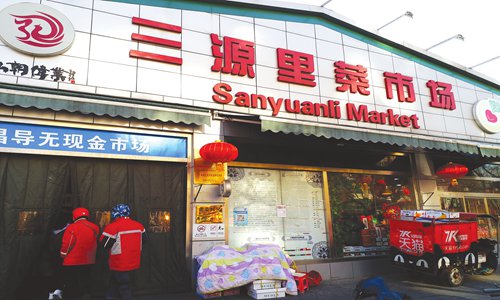Tastes of Belt and Road converge in Beijing’s Sanyuanli Market
Source:Xinhua Published: 2019/11/6 16:43:40

Cheese imported from France on sale at Sanyuanli Market on September 28, 2017 Photo: IC

The entrance to Sanyuanli Market in Beijing Photo: IC
Although the weather is getting colder in Beijing, Sanyuanli Market is seething with vitality and bustling with crowds of people dedicated to the pursuit of taste.
Zhang Xiaohua, a Beijing resident originally from East China's Fujian Province, never imagined her newfound love of tom yum soup would bring such extreme changes and surprises to her life.
"This is a piece of Thailand lime leaf," she explained while tearing a leaf into two.
"When you feel blue, you can smell it and you'll soon feel relaxed."
Every time a new customer comes, Zhang always provides tips for cooking with her many ingredients.
Zhang is a case in point among Chinese people who enjoyed the benefits of China's opening up. Starting from scratch with her husband in their tiny little Chinese spice stall 17 years ago in Sanyuanli Market, Zhang succeeded in establishing her kingdom full of spices and dried fruits with thousands of customers from all over the world.
Now, fresh ingredients arrive on Zhang's shelves twice a week by air.
Thousands of years ago, Western spices entered China via the Silk Road by camel and ship in exchange for Chinese silk, bringing about cultural exchanges between the East and the West. Nowadays, through railways, planes and giant container ships, it is a piece of cake to import the freshest ingredients from all across the world.
"In 2003, a regular customer of mine brought me a gift from Thailand, it was a bag of dry tom yum spices. I cooked it back home and as soon as I tasted it, I was enchanted by the unique flavor," Zhang said.
In order to find the same flavor, she went to Thailand and Malaysia to look for business partners and try to bring all the freshest ingredients to China.
Thanks to the Belt and Road Initiative, logistics and transportation, which are becoming more and more convenient, not only benefits China's local business people but also draws neighboring countries and even the world closer.
Since China joined the WTO in 2001, the scale of trade in goods has grown significantly. In 2018, China had more than 230 trading partners and its imports accounted for 10.8 percent of the world's total.
From 2013 to 2018, China's trade relations with countries along the Belt and Road have also become increasingly close. The volume of trade from countries along the Belt and Road has exceeded $6 trillion, with an average annual growth of 4 percent.
Located in one of the most international districts in Beijing, and surrounded by many embassies and foreign enterprises, tastes from all over the world converge in Sanyuanli Market, attracting people in pursuit of new flavors.
According to the Foreign Affairs Office of the People's Government of Beijing Municipality, by the end of 2018, the number of overseas institutions in Beijing had reached 37,000, with a total of 142,000 foreign residents.
Zhang has numerous Southeast Asian customers in Beijing, including overseas students, foreign employees and chefs of foreign restaurants.
It is easy to catch the smell of parsley and rosemary, and the briny smell of French oyster, Alaska salmon and Boston lobster, followed by Thai spices, German sausage and Dutch cheese in the market.
Sometimes, international students come with their mother's recipe in hand, trying to find the taste of home.
"I met some Malaysian students in Beijing. They bring a year's worth of ingredients with them every time they come to Beijing, and whenever they miss their families, they cook to ease their homesickness," Zhang said.
The 27-year-old Sanyuanli Market, as a kaleidoscope of international culinary cultures, always stands there witnessing the vitality of business brought by China's economic growth and opening up.
Posted in: FOOD,CULTURE & LEISURE